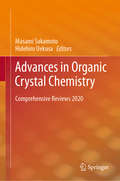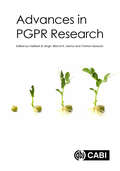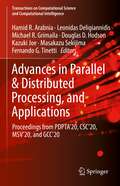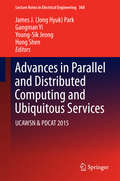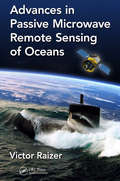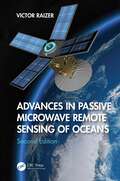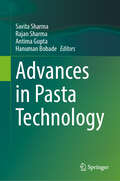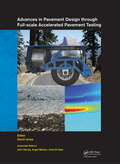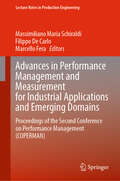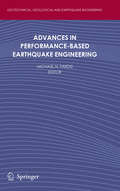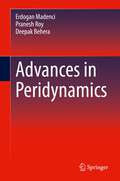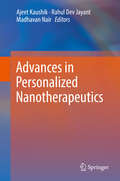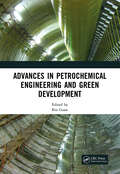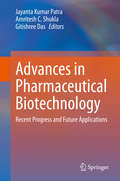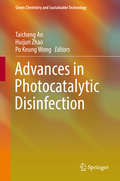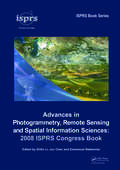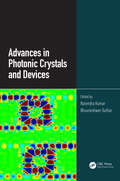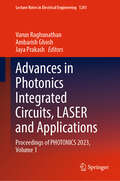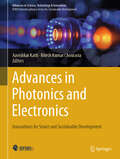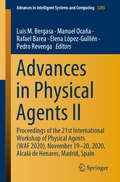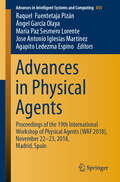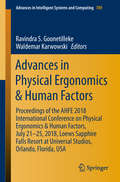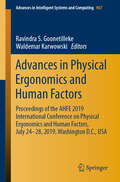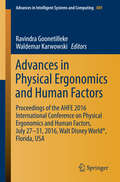- Table View
- List View
Advances in Organic Crystal Chemistry: Comprehensive Reviews 2020
by Masami Sakamoto Hidehiro UekusaThis book summarizes and records the recent notable advances in diverse topics in organic crystal chemistry, which has made substantial progress along with the rapid development of a variety of analysis and measurement techniques for solid organic materials. This review book is one of the volumes that are published periodically on this theme. The previous volume, published in 2015, systematically summarized the remarkable progress in assorted topics of organic crystal chemistry using organic solids and organic–inorganic hybrid materials during the previous 5 years, and it has been widely read. The present volume also shows the progress of organic solid chemistry in the last 5 years, with contributions mainly by invited members of the Division of Organic Crystal Chemistry of the Chemical Society of Japan (CSJ), together with prominent invited authors from countries other than Japan.
Advances in PGPR Research
by Virendra S. Bisaria Randy Ortiz-Castro Robert Hill Jose López-Bucio Madhu Kamle Pradeep Kumar Dubey Rama Kant Dubey Kartikay Bisen Dr Chetan Keswani P. C. Abhilash Betina Cecilia Agaras Gautam Anand Laith K. Al-Ani Fabiola Padilla Arizmendi Fatima Berenice Salazar-Badillo Mansi Bakshi E. J. Bedmar Adrien Biessy Marieta Marin Bruzos Jesús Salvador López-Bucio Jorge Armando Mauricio-Castillo Vasvi Chaudhry Niladri Chaudhry Manoj Kumar Chitara Pooja Choudhary Manish Kumar Dubey Sheikh Adil Edirisi Martin Filion Elisabetta Franchi Deepika Goyal Natalia Cripps-Guazzone Antonio Castellano-Hinojosa Angela Cristina Ikeda María Fernanda Nieto-Jacobo Diwakar Kandula Gagan Kumar Punam Kumari Richard Daniel Lally Robert Lawry Guillermo Nogueira-López Anupam Maharshi Shrikant S. Mantri Rafael Jorge Marcillo Dmitri V. MavrodiRhizosphere biology is approaching a century of investigations wherein growth-promoting rhizomicroorganisms (PGPR) have attracted special attention for their ability to enhance productivity, profitability and sustainability at a time when food security and rural livelihood are a key priority. Bio-inputs - either directly in the form of microbes or their by-products - are gaining tremendous momentum and harnessing the potential of agriculturally important microorganisms could help in providing low-cost and environmentally safe technologies to farmers.One approach to such biologically-based strategies is the use of naturally occurring products such as PGPR. Advances in PGPR Research explores recent developments and global issues in biopesticide research, presented via extended case studies and up-to-date coverage of: · Low input biofertilizers and biofungicides used for sustainable agriculture. · Molecular techniques to enhance efficacy of microbial inputs. · Intellectual property issues in PGPR research. Written by an international team of experts, this book considers new concepts and global issues in biopesticide research and evaluates the implications for sustainable productivity. It is an invaluable resource for researchers in applied agricultural biotechnology, microbiology and soil science, and also for industry personnel in these areas.
Advances in Parallel & Distributed Processing, and Applications: Proceedings from PDPTA'20, CSC'20, MSV'20, and GCC'20 (Transactions on Computational Science and Computational Intelligence)
by Hamid R. Arabnia Leonidas Deligiannidis Fernando G. Tinetti Michael R. Grimaila Douglas D. Hodson Kazuki Joe Masakazu SekijimaThe book presents the proceedings of four conferences: The 26th International Conference on Parallel and Distributed Processing Techniques and Applications (PDPTA'20), The 18th International Conference on Scientific Computing (CSC'20); The 17th International Conference on Modeling, Simulation and Visualization Methods (MSV'20); and The 16th International Conference on Grid, Cloud, and Cluster Computing (GCC'20). The conferences took place in Las Vegas, NV, USA, July 27-30, 2020. The conferences are part of the larger 2020 World Congress in Computer Science, Computer Engineering, & Applied Computing (CSCE'20), which features 20 major tracks. Authors include academics, researchers, professionals, and students.Presents the proceedings of four conferences as part of the 2020 World Congress in Computer Science, Computer Engineering, & Applied Computing (CSCE'20);Includes the research tracks Parallel and Distributed Processing, Scientific Computing, Modeling, Simulation and Visualization, and Grid, Cloud, and Cluster Computing;Features papers from PDPTA’20, CSC’20, MSV’20, and GCC’20.
Advances in Parallel and Distributed Computing and Ubiquitous Services: UCAWSN & PDCAT 2015 (Lecture Notes in Electrical Engineering #368)
by Hong Shen James J. Jong Hyuk Park Gangman Yi Young-Sik JeongThis book contains the combined proceedings of the 4th International Conference on Ubiquitous Computing Application and Wireless Sensor Network (UCAWSN-15) and the 16th International Conference on Parallel and Distributed Computing, Applications and Technologies (PDCAT-15). The combined proceedings present peer-reviewed contributions from academic and industrial researchers in fields including ubiquitous and context-aware computing, context-awareness reasoning and representation, location awareness services, and architectures, protocols and algorithms, energy, management and control of wireless sensor networks. The book includes the latest research results, practical developments and applications in parallel/distributed architectures, wireless networks and mobile computing, formal methods and programming languages, network routing and communication algorithms, database applications and data mining, access control and authorization and privacy preserving computation.
Advances in Passive Microwave Remote Sensing of Oceans
by Victor RaizerThis book demonstrates the capabilities of passive microwave technique for enhanced observations of ocean features, including the detection of (sub)surface events and/or disturbances while laying out the benefits and boundaries of these methods. It represents not only an introduction and complete description of the main principles of ocean microwave radiometry and imagery, but also provides guidance for further experimental studies. Furthermore, it expands the analysis of remote sensing methods, models, and techniques and focuses on a high-resolution multiband imaging observation concept. Such an advanced approach provides readers with a new level of geophysical information and data acquisition granting the opportunity to improve their expertise on advanced microwave technology, now an indispensable tool for diagnostics of ocean phenomena and disturbances.
Advances in Passive Microwave Remote Sensing of Oceans
by Victor RaizerThis new edition introduces the fundamentals of passive microwave remote sensing of oceans, including the physical principles of microwave radiometry, novel observational data, their interpretation, and applications. It not only demonstrates and examines the recent advantages and state of the art of microwave data but also provides guidance for explaining complex ocean studies and advanced applications. All chapters are thoroughly updated with detailed analysis of space‑based microwave missions, and a new chapter on space‑based microwave radiometer experiments has been added. This book discusses the power of microwave remote sensing as an efficient tool for diagnostics of ocean phenomena in research and education.Features New to this Edition:• Includes a new chapter and additional data, images, illustrations, and references.• Uses ocean microwave data, acquired from different platforms, to illustrate different methods of analysis and interpretation.• Updates information on recent and important satellite missions dedicated to microwave remote sensing of oceans.• Offers more detailed analysis of multiband microwave data and images.• Provides examples of microwave data that cover different ocean environmental phenomena and hydro‑physical fields, including global and local ocean features.• Presents additional material on advanced applications, including detection capabilities.This book is intended for postgraduate students and professionals working in fields related to remote sensing, geography, oceanography, civil, environmental, and geotechnical engineering.
Advances in Pasta Technology
by Rajan Sharma Savita Sharma Antima Gupta Hanuman BobadePasta is a conventional Italian product made from durum wheat semolina and characterized by high protein content, firm shape and texture. Extrusion technology allows incorporation of a variety of ingredients to pasta such as legumes, millets, pseudo cereals and others including mushrooms, tubers and pigmented components to enrich conventional pasta. It is a convenient, popular and versatile product, offering the food industry and researchers the opportunity to offer high nutritional quality by using alternative ingredients of nutritive excellence with a high concentration of bioactive components which induce several health benefits through antioxidative pathways. To deal with compromised functional properties of resultant pasta, different techno-functional interventions including use of hydrocolloids and modification of flours which are used to improve rheological and textural profile are necessary.Advances in Pasta Technology documents the history of pasta and its rise from niche to mainstream. The book is divided into 4 sections including an introduction that covers pasta history, global market statistics, traditional pasta making technology and processing along with quality characteristics. Another section is dedicated to nutritive valorization of pasta including modulation in the bio-functional characteristics as a function of ingredients including development of gluten free pasta, micronutrient fortification approach and use of protein, fibre and antioxidant rich flours as potential alternative ingredients. Further sections focus on technological approaches to enhance the performance of specialty pasta including additives, modification of flours and processing techniques and quality management, plant project profile and cost analysis details. This text highlights every aspect of pasta science, technology and market control.
Advances in Pavement Design through Full-scale Accelerated Pavement Testing
by Ian MuehlenhausPack: Book and CDInternationally, full-scale accelerated pavement testing, either on test roads or linear/circular test tracks, has proven to be a valuable tool that fills the gap between models and laboratory tests and long-term experiments on in-service pavements. Accelerated pavement testing is used to improve understanding of pavement behavior,
Advances in Performance Management and Measurement for Industrial Applications and Emerging Domains: Proceedings of the Second Conference on Performance Management (COPERMAN) (Lecture Notes in Production Engineering)
by Marcello Fera Massimiliano Maria Schiraldi Filippo De CarloThis book is a compilation of the papers presented at the COPERMAN 2023 conference, a meeting that bridges the gap between academia and industry in the field of performance management. This international conference brought together scientists and engineers from around the world to discuss and address many themes related to performance management, including the development of new methods and systems for performance measurement and management, the evaluation of human performance in various industrial contexts (including modern Industry 4.0 factory environments), and methodologies for business deployment. The book is for academics, graduate students, researchers, and industrial practitioners working in performance management. Its comprehensive coverage of diverse topics and cutting-edge research will provide readers with insights and knowledge that can be applied in their daily work, as well as inspire new research directions and interdisciplinary collaboration.
Advances in Performance-Based Earthquake Engineering (Geotechnical, Geological and Earthquake Engineering #13)
by Michael N. FardisPerformance-based Earthquake Engineering has emerged before the turn of the century as the most important development in the field of Earthquake Engineering during the last three decades. It has since then started penetrating codes and standards on seismic assessment and retrofitting and making headway towards seismic design standards for new structures as well. The US have been a leader in Performance-based Earthquake Engineering, but also Europe is a major contributor. Two Workshops on Performance-based Earthquake Engineering, held in Bled (Slovenia) in 1997 and 2004 are considered as milestones. The ACES Workshop in Corfu (Greece) of July 2009 builds on them, attracting as contributors world-leaders in Performance-based Earthquake Engineering from North America, Europe and the Pacific rim (Japan, New Zealand, Taiwan, China). It covers the entire scope of Performance-based Earthquake Engineering: Ground motions for performance-based earthquake engineering; Methodologies for Performance-based seismic design and retrofitting; Implementation of Performance-based seismic design and retrofitting; and Advanced seismic testing for performance-based earthquake engineering. Audience: This volume will be of interest to scientists and advanced practitioners in structural earthquake engineering, geotechnical earthquake engineering, engineering seismology, and experimental dynamics.
Advances in Peridynamics
by Erdogan Madenci Pranesh Roy Deepak BeheraThis book presents recent improvements in peridynamic modeling of structures. It provides sufficient theory and numerical implementation helpful to both new and existing researchers in the field. The main focus of the book is on the non-ordinary state-based (NOSB) peridynamics (PD) and its applications for performing finite deformation. It presents the framework for modeling high stretch polymers, viscoelastic materials, thermoelasticity, plasticity, and creep. It provides a systematic derivation for dimensionally reduced structures such as axisymmetric structures and beams. Also, it presents a novel approach to impose boundary conditions without suffering from displacement kinks near the boundary. Furthermore, it presents refinements to bond-based PD model by including rotation kinematics for modeling isotropic and composite materials. Moreover, it presents a PD – FEM coupling framework in ANSYS based on principle for virtual work. Lastly, it presents an application of neural networks in the peridynamic (PINN) framework. Sample codes are provided for readers to develop hands-on experience on peridynamic modeling. Describes new developments in peridynamics and their applications in the presence of material and geometric nonlinearity; Describes an approach to seamlessly couple PD with FE; Introduces the use of the neural network in the PD framework to solve engineering problems;Provides theory and numerical examples for researchers and students to self-study and apply in their research (Codes are provided as supplementary material);Provides theoretical development and numerical examples suitable for graduate courses.
Advances in Personalized Nanotherapeutics
by Ajeet Kaushik Rahul Dev Jayant Madhavan NairPersonalized health care to manage diseases and optimized treatment is crucial for everyone to maintain health quality. Significant efforts have been made to design and develop novel nano-enabling therapeutic strategies to cure and monitor diseases for personalized health care. As state-of-the-art, various strategies have been reported to develop personalized nanomedicine to combat against target diseases with no side effects. In this book proposal, we are trying to describe fundamentals of personalized nanomedicine, novel nanomaterials for drug delivery, role of nanotechnology for efficient therapeutics approach, nano-pharmacology, targeted CNS drug delivery, stimuli responsive drug release and nanotechnology for diseases management. This book would serve as a platform for new scholars to understand state-of-the-art of nanotechnology for therapeutics and designing their future research to develop effective personalized nanomedicine against targeted diseases. As of now, various studies have been reported to design and develop nanomedicines of higher efficacy but unfortunately, such products are up to laboratory research only and need to be well-tested using pre-clinical or human models. Our book would be a call for experts to explore multidisciplinary research for developing novel and efficient approaches to explore smart efficient nanocarriers for site-specific on-demand controlled drug delivery to combat against targeted diseases to personalized health care.
Advances in Petrochemical Engineering and Green Development: Proceedings of the 3rd International Conference on Petrochemical Engineering and Green Development (ICPEGD 2022), Shanghai, China, 25-27 February 2022
by Bin GuanAdvances in Petrochemical Engineering and Green Development is a compilation of selected papers from the 3rd International Conference on Petrochemical Engineering and Green Development (ICPEGD 2022) and focuses on the research of petrochemical engineering. The proceedings features the most cutting-edge research directions and achievements related to geology and green development. Subjects in this proceedings include: Petroleum and Petrochemical Engineering Fossil Technologies Oil & Gas Production Renewable Energy Sources and Technology Green Synergy Innovation Urban Crisis Management The collection of papers in this proceedings will promote the development of petrochemical industry and energy, resource sharing, flexibility and high efficiency. Thereby, it will promote scientific information interchange between scholars from top universities, research centers and high-tech enterprises working all around the world.
Advances in Petroleum Engineering and Petroleum Geochemistry: Proceedings Of The 1st Springer Conference Of The Arabian Journal Of Geosciences (cajg-1), Tunisia 2018 (Advances in Science, Technology & Innovation)
by Santanu Banerjee Reza Barati Shirish PatilThis edited volume is based on the best papers accepted for presentation during the 1st Springer Conference of the Arabian Journal of Geosciences (CAJG-1), Tunisia 2018. The book is of interest to all researchers in the fields of petroleum engineering, reservoir engineering and petroleum geochemistry. The MENA region accounts for more than 50 percent of the world's hydrocarbon reserves. Despite being the largest oil and gas producer of the world, the MENA countries face routine problems regarding petroleum engineering, reservoir modelling and production optimization. This volume offers an overview of the latest information and ideas regarding reservoir engineering, petrophysical engineering, petroleum system modelling, non-conventional energy resources and environmental impact of oil production.
Advances in Pharmaceutical Biotechnology: Recent Progress and Future Applications
by Jayanta Kumar Patra Gitishree Das Amritesh C. ShuklaThis book explains both the basic science and the applications of biotechnology-derived pharmaceuticals, with special emphasis on their clinical uses. The foundations of pharmaceutical biotechnology lie mainly in the capability of plants, microorganism, and animals to produce low and high molecular weight compounds useful as therapeutics. Pharmaceutical biotechnology has flourished since the advent of recombinant DNA technology and metabolic engineering, supported by the well-developed bioprocess technology. A large number of monoclonal antibodies and therapeutic proteins have been approved, delivering meaningful contributions to patients’ lives, and the techniques of biotechnology are also a driving force in modern drug discovery. Due to this rapid growth in the importance of biopharmaceuticals and the techniques of biotechnologies to modern medicine and the life sciences, the field of pharmaceutical biotechnology has become an increasingly important component in the education of pharmacists and pharmaceutical scientists. This book will serve as a complete one-stop source on the subject for undergraduate and graduate pharmacists, pharmaceutical science students, and pharmaceutical scientists in industry and academia.
Advances in Photocatalytic Disinfection (Green Chemistry and Sustainable Technology)
by Taicheng An Huijun Zhao Po Keung WongThis book presents the latest results related to photocatalytic inactivation/killing of microorganisms, which is a promising alternative disinfection method that produces less or even no disinfection byproduct. The book is divided into 13 chapters, which introduce readers to the latest developments in the photocatalytic disinfection of microorganisms, examine essential photocatalytic (PC) and photoelectrocatalytic (PEC) disinfection studies, and forecast and make recommendations for the further development of PC and PEC disinfection. Bringing together contributions by various leading research groups worldwide, it offers a valuable resource for researchers and the industry alike, as well as the general public. Taicheng An, PhD, is Chair Professor and Director at the Institute of Environmental Health and Pollution Control, School of Environmental Science and Engineering, Guangdong University of Technology, Guangzhou, China. Huijun Zhao, PhD, is Chair Professor and Director at the Centre for Clean Environment and Energy & Griffith School of Environment, Griffith University, Australia. Po Keung Wong, PhD, is a Professor at the School of Life Sciences, the Chinese University of Hong Kong, Hong Kong SAR, China.
Advances in Photogrammetry, Remote Sensing and Spatial Information Sciences: 2008 ISPRS Congress Book (ISPRS Book Series)
by Jun Chen Zhilin Li Emmanuel BaltsaviasPublished on the occasion of the XXIst Congress of the International Society for Photogrammetry and Remote Sensing (ISPRS) in Beiijng, China in 2008, Advances in Photogrammetry, Remote Sensing and Spatial Information Sciences: 2008 ISPRS Congress Book is a compilation of 34 contributions from 62 researchers active within the ISPRS. The book covers
Advances in Photonic Crystals and Devices
by Narendra Kumar Bhuvneshwer SutharIn recent decades, there has been a phenomenal growth in the field of photonic crystal research and has emerged as an interdisciplinary area. Photonic crystals are usually nanostructured electromagnetic media consisting of periodic variation of dielectric constant, which prohibit certain electromagnetic wave frequency ranges called photonic bandgaps to propagate through them. Photonic crystals elicited numerous interesting features by unprecedented control of light and their exploitation is a promising tool in nanophotonics and designing optical components. The book ‘Advances in Photonic Crystals and Devices’ is designed with 15 chapters with introductory as well as research and application based contents. It covers the following highlighted features: Basics of photonic crystals and photonic crystal fibers Different theoretical as well as experimental approaches Current research advances from around the globe Nonlinear optics and super-continuum generation in photonic crystal fibers Magnetized cold plasma photonic crystals Liquid crystal defect embedded with graphene layers Biophysics and biomedical applications as optical sensors Two-dimensional photonic crystal demultiplexer Optical logic gates using photonic crystals A large number of references The goal of this book is to draw the background in understanding, fabrication and characterization of photonic crystals using a variety of materials and their applications in design of several optical devices. Though the book is useful as a reference for the researchers working in the area of photonics, optical computing and fabrication of nanophotonic devices, it is intended for the beginners like students pursuing their masters’ degree in photonics.
Advances in Photonics Integrated Circuits, LASER and Applications: Proceedings of PHOTONICS 2023, Volume 1 (Lecture Notes in Electrical Engineering #1241)
by Jaya Prakash Varun Raghunathan Ambarish GhoshThis book presents the select proceedings of the Biennial Photonics Conference (Photonics 2023) held at IISc, Bengaluru on 5-8 July 2023. It covers topics across multiple areas of photonics, including established areas like optical communication and networks, quantum optics, non-linear and ultrafast photonics, nanophotonics, biophotonics and bioimaging, photonic integrated circuits, fibers and sensors, optical materials and fabrication techniques, optical metrology, and instrumentation, optofluidics, laser applications, optoelectronics. The book also covers emerging areas in photonics, such as THz photonics, structured Light, 2D materials, optomechanics, topological photonics, and AI/ML in photonics. The book will be useful for researchers and professionals interested in the broad field of photonics.
Advances in Photonics and Electronics: Innovations for Smart and Sustainable Development (Advances in Science, Technology & Innovation)
by Aavishkar Katti Ritesh Kumar ChourasiaThe book presents the collated and high-quality proceedings of the Conference on Recent Technologies in Electronics and Photonics held during 9-10 February 2024 at MIT-WPU, Pune, India. The main objective of this book is the introduction of recent innovations and current trends of photonics and electronics along with advanced device applications. Photonics and electronics together are shaping up to be the two main pillars of innovation for sustainable development and technological advances. The emphasis in this book will be on presenting recent application-based research in the mentioned fields rather than purely theoretical ideas. The readers will gain insights on recent innovations across many fields of photonics on one hand: laser science and nonlinear optics, photonic materials, nanophotonics, solar photovoltaics, optoelectronics, green photonics, and fiber optics and a diverse set of topics in electronics on the other: Semiconductor Electronics, Electronic Materials, Microelectronics, AI/ML, Internet of Things etc. The book is useful for early career researchers in Science and Engineering, as also university professors and industry professionals.
Advances in Physical Agents II: Proceedings of the 21st International Workshop of Physical Agents (WAF 2020), November 19-20, 2020, Alcalá de Henares, Madrid, Spain (Advances in Intelligent Systems and Computing #1285)
by Luis M. Bergasa Manuel Ocaña Rafael Barea Elena López-Guillén Pedro RevengaThe book reports on cutting-edge Artificial Intelligence (AI) theories and methods aimed at the control and coordination of agents acting and moving in a dynamic environment. It covers a wide range of topics relating to: autonomous navigation, localization and mapping; mobile and social robots; multiagent systems; human-robot interaction; perception systems; and deep-learning techniques applied to the robotics. Based on the 21st edition of the International Workshop of Physical Agents (WAF 2020), held virtually on November 19-20, 2020, from Alcalá de Henares, Madrid, Spain, this book offers a snapshot of the state-of-the-art in the field of physical agents, with a special emphasis on novel AI techniques in perception, navigation and human robot interaction for autonomous systems.
Advances in Physical Agents: Proceedings of the 19th International Workshop of Physical Agents (WAF 2018), November 22-23, 2018, Madrid, Spain (Advances in Intelligent Systems and Computing #855)
by Raquel Fuentetaja Pizán Ángel García Olaya Maria Paz Sesmero Lorente Jose Antonio Iglesias Martínez Agapito Ledezma EspinoThe book reports on cutting-edge theories and methods aimed at the control and coordination of agents acting and moving in a dynamic environment. It covers a wide range of systems, including multiagent systems, domotic agents, robotic manipulators, soccer robots, autonomous and semiautonomous robots, as well as systems for industrial applications. Advances in software agents, sensors, computer visions and other related areas are also thoroughly discussed and presented in detail. Based on the 19th edition of the International Workshop of Physical Agents (WAF 2018), held on November 22-23, 2018, in Madrid, Spain, this book offers a snapshot of the state-of-the-art in the field of physical agents, with a special emphasis on autonomous systems such as mobile robots, industrial process or other complex systems.
Advances in Physical Ergonomics & Human Factors: Proceedings of the AHFE 2018 International Conference on Physical Ergonomics & Human Factors, July 21-25, 2018, Loews Sapphire Falls Resort at Universal Studios, Orlando, Florida, USA (Advances in Intelligent Systems and Computing #789)
by Waldemar Karwowski Ravindra S. GoonetillekeThis book reports on the state of the art in physical ergonomics and addresses the design of products, processes, services, and work systems to ensure they are productive, safe, and enjoyable for people to use. The human body’s responses to physical and physiological work demands, strain injuries from repetition, vibration, force, and posture are the most common types of issues examined, along with their design implications. The book explores a wide range of topics in physical ergonomics, including the consequences of repetitive motion, materials handling, workplace safety, the usability of portable devices, design, working postures, and the work environment. Mastering physical ergonomics and safety engineering concepts is fundamental to creating products and systems that people can safely and conveniently use, as well as avoiding stresses and minimizing the risk of accidents. Based on the AHFE 2018 Conference on Physical Ergonomics and Human Factors, held on July 21–25, 2018, in Orlando, Florida, USA, this book provides readers with a comprehensive perspective on the current challenges in physical ergonomics, which is a critical aspect in the design of any human-centered technological system, and for factors influencing human performance.
Advances in Physical Ergonomics and Human Factors: Proceedings Of The Ahfe 2017 Conference On Physical Ergonomics And Human Factors, July 17-21, 2017, Los Angeles, California, Usa (Advances in Intelligent Systems and Computing #602)
by Waldemar Karwowski Ravindra S. GoonetillekeThis book reports on the state of the art in physical ergonomics and is concerned with the design of products, process, services, and work systems to assure their productive, safe, and satisfying use by people. With focus on the human body's responses to physical and physiological work demands, repetitive strain injuries from repetition, vibration, force, and posture are the most common types of issues examined, along with their design implications. The book explores a wide range of topics in physical ergonomics, which includes the consequences of repetitive motion, materials handling, workplace safety, and usability in the use of portable devices, design, working postures, and the work environment. Mastering physical ergonomics and safety engineering concepts is fundamental to the creation of products and systems that people are able to use, as well as the avoidance of stresses and minimization of the risk of accidents. Based on the AHFE 2016 International Conference on Physical Ergonomics & Human Factors, held on July 27-31, 2016 in Walt Disney World®, Florida, USA, the book provides readers with a comprehensive view of the current challenges in Physical Ergonomics, which are a critical aspect in the design of any human-centered technological system, and factors influencing human performance.
Advances in Physical Ergonomics and Human Factors: Proceedings of the AHFE 2016 International Conference on Physical Ergonomics and Human Factors, July 27-31, 2016, Walt Disney World®, Florida, USA (Advances in Intelligent Systems and Computing #489)
by Ravindra Goonetilleke Waldemar KarwowskiTaking the field of human factors and ergonomics beyond state of the art, this volume focuses on advances in the use of ergonomics modeling and on the evaluation of usability, which is a critical aspect of any human-technology system. The research described in the book's 70 chapters is an outcome of dedicated research by academics and practitioners from around the world, and across disciplines. The chapters are organized under five sections: I. Models and Methods II. Vision and Visual Displays , III. Product Design and User Interfaces IV. Input Devices and Computer Based Systems V. Individual and Environmental Technology Related Issues. This work provides an invaluable resource for evaluating products and environments and designing future ones that are intuitive, safe, and easy to use. Seven other titles in the Advances in Human Factors and Ergonomics Series are: Advances in Human Factors and Ergonomics in Healthcare Advances in Applied Digital Human Modeling Advances in Cross-Cultural Decision Making Advances in Cognitive Ergonomics Advances in Occupational, Social and Organizational Ergonomics Advances in Human Factors, Ergonomics and Safety in Manufacturing and Service Industries Advances in Neuroergonomics and Human Factors of Special Populations
